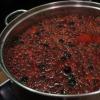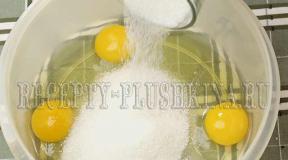Making homemade grape vinegar. How to make wine vinegar
Wine vinegar is widely used in cooking. It is white and red like the wine from which this product is prepared. If you prepare vinegar from white wine, then it will be white, from red, respectively, red. Wine vinegar is produced by industrial fermentation of wine.
You don't have to buy ready-made wine vinegar from the store, because you can make it yourself. And although the fermentation process, which results in wine vinegar, is quite laborious, you can use a simplified method of cooking at home.
Several ways to make homemade wine vinegar
If you are unsure of how to make wine vinegar at home, we recommend using one of two methods.
The first method is the simplest and fastest. Save a bottle of dry wine for making vinegar. During the week, perform the following manipulations: leave the bottle of wine open for a day, and plug it with a cork overnight. As a result, in just a week, you will have a fragrant vinegar dressing for Greek salad. This method allows you to get light wine vinegar, which in its characteristics is far from aged in an oak barrel. However, it will add flavor and aroma to your light salads.
If you are ready to spend more time and have patience, then it is better to use the more complex method. To do this, stock up on the following ingredients:
- a bottle of dry wine with a capacity of 0.75 liters;
- 50 ml starter culture;
- a small piece of oak wood;
- capacious glass container for fermentation.
Fermented grape juice or the remnants of store-bought wine vinegar can serve as sourdough.
Pour dry wine into a glass container. Add sourdough and a piece of oak wood to it. We close the container with a lid, allowing excess gas to escape freely during fermentation. We send a container with contents from a dark warm place for 30-40 days. After this period of time, the vinegar will reach the required state and acquire a rich, mature taste and aroma.
Wine vinegar is added to a variety of salads, both warm and cold. You can also flavor sandwiches with ham, tomatoes and mushrooms with wine vinegar.
This method was invented by winemakers so as not to throw away the waste remaining after the manufacture of alcoholic beverages. To make homemade vinegar you will need:
- pulp (grape pomace) - about a kilogram;
The remains from the winemaking process are placed in a glass container with a wide neck and filled with water. Then sugar is added. If you like a more acidic product, you can take less sugar.
Close the mouth of the jar tightly with a cotton cloth or gauze. We put the container in a warm place (at least 20 degrees), in the dark. The vinegar will ripen for about two weeks. During fermentation, the mixture must be stirred periodically with a wooden stick or spoon.
After 14 days, the composition must be filtered by squeezing out the thick. Add another 70 grams of sugar to the liquid, mix and, wrapping the neck with a cloth, send it to ripen in a warm, dark place. Now you need to track the moment until the vinegar turns light and stops fermenting. It will take about a month, after which the liquid is filtered and poured into bottles.
A simple grape vinegar recipe
If you are not keen on making wine, you can make vinegar from grapes. For a liter of water you will need:
- 800 g of grapes;
- 10 g dry yeast.
The grapes are separated from the twigs and washed thoroughly, after which they are kneaded with a wooden spoon or crush. Then add the remaining ingredients to the mixture. The composition is laid out in a glass jar, on which a medical glove is put on. Remember to pierce one of her fingers.
The jar is placed in a warm, dark place to ripen the vinegar. It usually takes 20 days. You will determine your readiness for the next stage by the fact that the glove will inflate and then fall off. After that, the composition is filtered and placed again in a dark, warm room.
It is not difficult to determine the readiness of the vinegar - the liquid will become light and translucent. Bottle it with paper stoppers. When all the oxygen comes out (after about a couple of days), seal with wax or tight plugs.
To make vinegar from grapes at home, you can use both light and dark varieties of berries. The finished product should be stored in glass bottles or jars so as not to provoke the oxidation process.
How to make vinegar from grapes at home, recipe
How to make vinegar from grapes at home? Find simple recipes in this article.
In taste, aroma and other culinary qualities, grape vinegar differs markedly from other products containing acetic acid, especially synthetic ones. In cooking, this substance is used very actively and successfully, and the presence of vitamins A and C in wine vinegar, as well as a large amount of minerals, including potassium, fluorine, phosphorus, iron, calcium, magnesium, makes it possible to use it as a medicinal and prophylactic preparation. ...
The preparation of grape vinegar is not such a difficult procedure, given that the components of the implementation of this process can be waste and residues from the process of making grape wine.
In cooking, grape vinegar is used as a dressing for both vegetable and meat salads, for marinating fish and meat. It can be used in all dishes where other varieties of vinegar are used, but it can be used to emphasize the taste of foods and give them a zesty astringency.
The benefits of grape vinegar
- has a beneficial effect on the digestive tract,
- improves the function of the gallbladder, kidneys, liver, rectum,
- and the external use of grape vinegar in the form of rubbing the legs allows you to get rid of puffiness, relieve fatigue and prevent varicose veins.
The use of vinegar from grapes in cosmetology
In cosmetology, this drug is used for rubdowns. This procedure gives the skin elasticity, relieves skin inflammation, ensures smoothness and elasticity of the skin. Grape vinegar removes calluses and calluses from rough feet. A weak vinegar solution is also used to rinse hair, this tool allows you to give it softness and shine.
The use of grape vinegar in dietetics
In dietetics, grape vinegar mixed with honey removes toxins and unnecessary salts from the body, it is able to dull appetite and normalize stools. At home, to make grape vinegar, you can use pomace, yeast residues of grapes, damaged berries that remain after the grapes are sorted out.
How to make grape vinegar at home?
To start the process of preparing vinegar, you should stock up on this waste (pulp), sugar and boiled water.
- Half a glass jar with a wide mouth should be filled with the pulp and water should be added, while a liter of water should fall on eight hundred grams of grape pulp.
- Then add sugar at the rate of fifty to one hundred grams per liter of water. The more sugar, the more concentrated the vinegar will turn out, that is, the more acidic.
- After all these manipulations, the neck of the can is tied with gauze and placed in a warm and dark place. The process should take place at a temperature of at least twenty degrees, the optimal range is 20-30 o C.
- The wort should ferment for one and a half to two weeks. If you stir the contents of the jar with a wooden spoon every day and thus saturate it with oxygen, the fermentation process will accelerate.
- At the end of fermentation, the mass should be transferred to a gauze bag and squeezed, and the collected liquid should be filtered through cheesecloth and poured into a glass container.
- Then sugar is added again at the rate of fifty to one hundred grams of sugar per liter of mash. The mixture must be stirred until the sugar is completely dissolved.
- Next, the neck of the jar is closed again with gauze and the jar is placed in a warm place in order to carry out the final stage of fermentation. Fermentation can last from one and a half to two months. As a result, the liquid should lighten and completely stop fermenting.
- The finished vinegar should be filtered through cheesecloth again and then poured into glass bottles.
It is considered good form if labels with the name of the product and the date of preparation are glued to the bottles. It is most common among winemakers, who always have raw materials unused after making wine.
A simple grape vinegar recipe
There is also a simpler grape bite recipe that is used by housewives, as well as workers in restaurants and cafes. This requires eight hundred grams of grapes, two hundred grams of honey, ten grams of dry yeast and a liter of boiled water.
The washed berries are placed in a glass container and kneaded well with a wooden crush or hands. Then honey, yeast and water are added there. Then a rubber glove with a punctured hole is put on the neck of the can. The whole structure is placed in a warm place for two to three weeks. Fermentation begins. First, the glove in greeting will rise above the jar, and then fall off lifelessly - the fermentation is complete. After straining the mixture, it is again placed in a warm place. The vinegar is considered ready when the liquid has visited.
Grape vinegar at home: a recipe
In taste, aroma and other culinary qualities, grape vinegar differs markedly from other products containing acetic acid, especially synthetic ones.
How to make grape vinegar
Grape vinegar can be purchased at any store. But real homemade vinegar, prepared on your own, compares favorably with the purchased one in taste and usefulness, and it does not require a lot of effort and time.
To make grape vinegar at home, you can use yeast leftovers of grapes, pomace, as well as damaged berries left after sorting the grapes.
Vinegar from grape waste
- Place the pulp in a glass jar with a wide neck so that it takes up ½ of the container.
- We add water to the mass, at the rate of: 1 liter of water per 800 g of grape pulp.
- Add sugar: 50-100 grams of sugar for every liter of water. The more sugar there is, the more acidic (concentrated) the vinegar will be.
- We tie the neck of the jar with gauze and put it in a dark, warm place - the temperature should be at least 20-30 degrees.
- Leave the wort to ferment for 10-14 days. During this time, daily it is necessary to thoroughly stir the contents of the jar with a wooden spoon in order to saturate it with oxygen and speed up the fermentation process.
- After fermentation, transfer the mass to a gauze bag and squeeze.
- Filter the resulting juice through cheesecloth and pour it into a glass vessel.
- Add sugar: for 1 liter of mash - 50-100 g of sugar, and stir until completely dissolved.
- Wrap the neck of the jar with gauze again and put it in a warm place for the final completion of fermentation.
- The fermentation process can take from 40 to 60 days until the liquid lightens and stops fermenting completely.
- Filter the finished vinegar through cheesecloth and pour it into glass bottles.
This method of making grape vinegar is the most common among winemakers who have unused raw materials left over after making the wine.
Grape juice vinegar
This is an easier-to-prepare grape bite recipe used in many restaurants and cafes, as well as common housewives.
- Grapes (800 grams);
- Honey (200 grams);
- Dry yeast (10 grams);
- Boiled water (1 liter).
- Rinse the grapes thoroughly and place in a glass container.
- Using a wooden pusher (or just with your hands), knead the grapes thoroughly.
- Add honey, yeast to the resulting mass and pour water.
- We put on a rubber medical glove on the top of the jar, after making a small hole in it.
- We put the container in a warm place for 2-3 weeks for fermentation. When the glove rises completely above the jar and then falls off, fermentation is complete.
- We filter the mixture through cheesecloth and put it back in a warm place.
- When the liquid brightens, the vinegar is ready.
The resulting vinegar is stored in a cool dry place.
- It is better to use honey instead of sugar for making vinegar. This will improve the taste of the vinegar and make it softer.
- After pouring vinegar into containers, it is better to first seal them with paper stoppers so that the remaining oxygen comes out. The bottles are then best sealed with wax or paraffin.
- Glassware is best used to store vinegar, as wood and metal utensils tend to oxidize.
How to make grape vinegar
To make grape vinegar at home, you can use yeast leftovers of grapes, pomace, as well as damaged berries left after sorting the grapes.
How to make grape vinegar?
Grapes are one of the most valuable sources of vitamins and minerals useful for the body. Not only fresh grapes are useful, but also products containing it: juices, wine, jam, compotes, vinegar. Let's talk about wine vinegar. This natural solution is used not only for cooking, but also in cosmetology, medicine and dietetics. How to make grape vinegar at home , learn from this article.
Benefits and Applications
In cooking, grape vinegar is used for pickles, sauces, and some desserts. This natural product reveals the flavor of the food, adding a spicy note.
- externally: for edema and salt deposition, as a prophylactic agent for varicose veins, to relieve itching from insect bites.
- internally: with gout, for the prevention of diseases of the heart and blood vessels.
Cosmetologists use grape vinegar quite widely:
- rinsing hair with a mild solution makes hair shiny and soft with regular use;
- face masks containing this product have a rejuvenating effect and lighten freckles;
- Wine vinegar can be used as a natural deodorant as it effectively neutralizes sweat odor.
Nutritionists advise to regularly consume a small amount with honey to remove toxins and toxins. In addition, the product dulls appetite, which is important for weight loss.
Recipe number 1: from grape pulp.
For this recipe, berries that are not suitable for wine and juice may be used. Fruits crumpled and bitten by insects are suitable, the main thing is that they are not washed, this will preserve the wild yeast. Or you can take the pomace remaining after making the juice.
- pulp or substandard grapes - 1.5 kg;
- sugar - a glass on the shoulders;
- water - 1.5 liters at room temperature.
Cooking.
All components are mixed in a three-liter jar. We keep the jar covered with gauze for 2.5-3 months in a dark place in a warm place. To activate the fermentation process, the contents of the jar must be saturated with oxygen, for this, once every 2-3 days, the liquid is mixed with a wooden spoon. Metal objects cannot be used. The finished vinegar is decanted, bottled and stored in a cool place.
Recipe number 2: from grape juice

Knead the berries with your hands. Since yeast is used for fermentation in the recipe, the grapes can be pre-washed. We mix the prepared raw materials with the rest of the components in a three-liter jar. We put a rubber glove on the jar and put the vinegar in a warm, dark place for a month. We decant the finished product and put it back in a warm place. The completion of the cooking process can be said when the liquid has completely cleared.
Recipe number 3: from grape leaves
Even grape leaves are good for making homemade vinegar. They also contain a lot of nutrients, and the finished product will be much healthier than the vinegar purchased at the store.

Wash oregano and leaves and cut into large pieces. We mix all the ingredients in a jar, fill with warm water, cover with gauze and put away for fermentation. It will take two months to prepare vinegar in a warm place without access to light. We bottle the finished product.
Homemade grape vinegar recipe how to cook
Wine vinegar - this natural solution is used not only for cooking, but also in cosmetology, medicine and nutrition. How to make vinegar from grapes at home, we learn from this article.
The history of the origin of grape vinegar is not known for certain, but thanks to archaeologists, we know that the product was popular for many millennia BC. Ancient healers used it as a remedy, beauties of those times used it as a cosmetic, culinary specialists - as a preservative. What are the benefits and harms of grape vinegar and how it is used - we will discuss today.
Description
Grape vinegar is a natural product that is obtained from grape wine as a result of fermentation of the product (in simple words, it is sour wine). After it is kept in oak barrels. The end result is a liquid with a pungent odor and sour taste of varying degrees of saturation.
Several varieties of the product are produced: white, red and balsamic. The third product is the most expensive, since the process of its preparation takes the most time and requires special technologies, however, its characteristics are also different: the liquid is thicker, similar to syrup, and the taste has some sweetness. 
How to get the
At home, you can apply the simplest recipe: heat dry white wine, evaporating it until it is halved in volume, without bringing it to a boil.
Second way.
- The pulp from the squeezed grapes is placed in a glass jar, covered with sugar and poured over with water. Proportions: for 800 grams of product, a liter of water and 100 grams of sugar.
- The neck of the container is tied with gauze and placed in a dark and warm place for fermentation for two weeks. During this time, the liquid is shaken to saturate with oxygen.
- After two weeks of fermentation, the liquid is filtered, squeezing out the thick mass. Another 100 grams of sugar is added to the resulting mash and left until the process is complete. Cooking time takes from forty to sixty days.
The product is ready when it has brightened and stopped fermenting.
- It is filtered and poured into bottles with a sealed stopper.
Composition and nutritional value
- Vitamins: A, B3, B5, C.
- Macronutrients: sodium, magnesium, phosphorus, potassium, calcium.
- Trace elements: fluorine, chlorine, zinc, manganese, iron.
- Organic acids: lactic, acetic, tartaric.
- Phenolic compounds.
- Antioxidants
- proteins: 0.04 g;
- fat: 0 g;
- carbohydrates: 0.27 g;
- calorie content: 9 kcal.
Did you know? An analogue of a modern battery existed about two thousand years ago. In 1936, the German archaeologist Wilhelm Koenig, during excavations near Baghdad, discovered an interesting find: an earthenware jug with a bitumen cork in the neck, through which an iron rod wrapped in copper wire passed, and inside the jug were the remains of a liquid resembling vinegar. In the course of an experiment conducted by American scientists, it turned out that grape vinegar played the role of an electrolyte. A copy of such a device, made by the Americans, generated electricity with a voltage of 0.5 volts.
The benefits of grape vinegar
 Due to its rich vitamin and mineral composition, the presence of acids and antioxidants, grape vinegar has a wide range of positive effects on the body.
Due to its rich vitamin and mineral composition, the presence of acids and antioxidants, grape vinegar has a wide range of positive effects on the body.
- Promotes the regeneration of the mucous membranes of the stomach and intestines.
- Promotes the production of enzymes that improve digestion.
- Improves metabolic processes, regulates cholesterol levels.
- Strengthens bone and muscle tissue, hair, nails.
- Supports the protective functions of the body.
- Reduces the risk of anemia, increases hemoglobin levels.
- Improves the elasticity of the walls of blood vessels, cleanses from cholesterol deposits.
- It has a regenerating, wound healing, anti-inflammatory effect.
- Restores strength, improves brain function.
- Supports the heart muscle.
- Promotes the production of sex hormones.
 The product is used for diseases of the rectum, skin diseases, gout, obesity, chronic fatigue, colds. For prophylactic purposes, it is used to reduce the risk of atherosclerosis.
The product is used for diseases of the rectum, skin diseases, gout, obesity, chronic fatigue, colds. For prophylactic purposes, it is used to reduce the risk of atherosclerosis.
The harm of grape vinegar
Due to its high acid content, this product can be harmful to health if consumed excessively. If abused, vinegar can cause heartburn and unpleasant belching, increase acidity in the stomach, thereby irritating its mucous membranes. This moment is fraught with gastrointestinal diseases.
The same acids and phenolic compounds can provoke a negative reaction in allergy sufferers, both when applied internally and externally. Before use for people prone to allergies, a tolerance test should be performed.
After consuming grape vinegar, it is advisable to rinse the mouth cavity, since the effect of acid on tooth enamel is destructive.  It is a misconception that ingestion for cystitis kills bacteria in the ureter. Acid breakdown products only aggravate the inflammatory process, delaying the treatment of the disease.
It is a misconception that ingestion for cystitis kills bacteria in the ureter. Acid breakdown products only aggravate the inflammatory process, delaying the treatment of the disease.
Important! Do not leave grape vinegar in a place accessible to small children: it can burn the insides, even death.
The use of grape vinegar in cooking
Popular use of "sour wine" as a marinade for meat and poultry, mushrooms, as well as for canning for the winter.
The wine ingredient is added to dressings for salads, seafood and herring, to add a spicy note - to vegetable side dishes, borscht, snacks, sauces and gravies.
If you add sugar to the product, you can replace wine with it in the recipe; when baking, for splendor, add soda slaked with vinegar to the dough, and wine is quite suitable for this. Grape vinegar goes well with vegetables, fish, meat and poultry, herbs and spices; balsamic is even used in desserts.
 There are also products with which it does not go well. A combination of vinegar with dairy and sour milk drinks and cottage cheese, with legumes and wheat, with potato dishes can lead to undesirable reactions. Sharing can cause bloating and flatulence.
There are also products with which it does not go well. A combination of vinegar with dairy and sour milk drinks and cottage cheese, with legumes and wheat, with potato dishes can lead to undesirable reactions. Sharing can cause bloating and flatulence.
In folk medicine
In folk recipes, the product is used to alleviate the condition with gout... The disease is provoked by salt deposits, which dissolve under the action of acid. Make a vinegar compress from a thick cloth soaked in liquid, leave it overnight, secured with an elastic bandage, but not tight so that there is good blood circulation.
For sore throat Gargling with grape vinegar will help destroy bacteria that have settled on the mucous membrane, while you need to dilute the product with water so as not to get burned. At high temperatures use vinegar rubdown, diluting the product with water at room temperature. The same rubbing of the legs will help get rid of fatigue, give tone to the venous vessels, reducing the risk varicose veins... Cold vinegar compresses will heal cracks and soothe inflammation when hemorrhoids.
One tablespoon of the product diluted in a glass of boiled water will help improve bowel function... They take this medicine for two weeks, half a glass twice a day before meals. 
The product is also used in home cosmetics. It tones and cleanses the skin, saturates it with useful substances, has an antiseptic and regenerating effect.
A vinegar compress is used to improve the condition of oily skin and cleanse it. From the gauze folded in several layers, prepare a base with slots for the eyes and mouth. Heat the vinegar liquid in a water bath to room temperature, soak a gauze base in it and put it on your face for 15 minutes. Then rinse with warm water. The procedure should not be carried out more than twice a month.
Important! Remember: on irritated and dry skin, such a compress is not desirable, it can dry out the upper layer of the epidermis and cause flaking and redness.
By adding a few drops to face masks, you can achieve the effect of lightening, narrowing pores, and healing microcracks. White liquid is used for bleaching.
Grape vinegar- natural vinegar, which is obtained by fermentation of grape wine. People have long used sour wine in cooking and medicine. Nowadays, grape bite is used as an effective medicine, as well as as a food product.
White and red wine vinegar and balsamic vinegar are varieties of grape.
Many housewives cannot distinguish grape vinegar from wine, and wine from balsamic. In fact, wine vinegar is made from red or white wine. The red wine bite is considered more savory. Wine vinegar is kept for a long time in special oak barrels, as a result, a product with a pronounced aroma is obtained, the acid content in it is at least 6%. White vinegar is considered milder and has a subtle odor. White vinegar is often used as a salad dressing in combination with sugar.
The most expensive vinegar is considered to be balsamic. This vinegar is a dark and thick vinegar with a sweet and sour taste. Balsamic vinegar, like the previous one, is prepared from wine, but using a different technology. The vinegar is left to ferment in barrels for several years. Therefore, this product has an impressive cost. Natural balsamic vinegar is obtained in small quantities: for example, from a 100-liter barrel you get only 15 liters of vinegar. Add balsamic vinegar to the dish before using it, use it in marinades.
Balsamic grape vinegar has been around for centuries. So, the first mention of this product is associated with the fact that somehow one marquis presented Henry II with a barrel with an unknown product. He liked it so much that balsamic vinegar has since been considered a royal gift, it was presented only to very respected people. The high cost and extraordinary taste made vinegar popular. It is believed that it was used by Casanova himself, known for his love victories. Balsamic grape vinegar gets its name from the fact that it was originally used in medicine as a treatment for wounds, as it has an anti-inflammatory effect.
How to determine naturalness?
You can buy grape vinegar in any supermarket and determine its naturalness according to the criteria listed below. When choosing such a product, first of all, you should pay attention to the price: good and truly natural grape vinegar cannot be cheap. Natural vinegar is obtained by fermenting wine as a result of the activity of acetic acid bacteria in alcohol-containing liquids.
According to GOST, natural vinegar must have a corresponding inscription on the label. If the composition contains dyes, preservatives, sugar, then the vinegar is unnatural.
A natural product will have little sediment in most cases. You can also determine the naturalness of vinegar by the acid content, the amount of which cannot exceed 5-9%.
Homemade grape vinegar can be made from dry white wine. The wine is heated, but not brought to a boil until its volume is halved.
You can also make vinegar at home from yeast leftovers from grapes. Pulp, or grape pomace, is placed in a jar, poured with water (1 liter of water per 800 g of product). For each liter of water, add 100 g of sugar ( the more sugar, the higher the concentration of acetic acid). The jar is tied with gauze and left for two weeks. Stir the contents daily to saturate the product with oxygen. After 14 days, the juice is filtered, sugar is added (for 1 liter of juice - 100 g of sugar). The mixture is placed again in a dark place. After 60 days, homemade grape vinegar will be ready, the liquid should lighten, and fermentation should stop.

Medicinal properties and application in cosmetology
The medicinal properties of this product are due to its composition. So, natural vinegar contains tartaric, lactic, pantheic acids. It is also rich in minerals potassium, iron. In ancient times, vinegar was used as a medicine for gout, and it was also used for vitamin deficiency.
Grape vinegar contains antioxidants, polyphenols, organic acids. These substances have a beneficial effect on the human body, prevent premature aging, and protect cells from oxidative processes. Vinegar contains phytoalexin, a substance that protects the body from tumors, the development of heart disease, and inflammatory processes.

In cosmetology, grape vinegar is used for skin care. In antiquity, it was used as the main ingredient in anti-aging masks. Vinegar makes the skin healthy, eliminates acne, acts as a mild exfoliation due to the content of organic acids. For people with fair skin, it is better to use white vinegar as it has a slight whitening effect. Grape vinegar will become a godsend for oily, porous skin, it will effectively cleanse the skin of blackheads and delicately whiten it. Vinegar promotes healing of small wounds and also makes scars and scars less visible.
Vinegar also has a beneficial effect on hair, it is used to make an excellent hair rinse, it makes hair manageable and shiny.
Grape vinegar often included in recipes for anti-cellulite cold wraps... In addition to getting rid of the "orange peel", vinegar has a beneficial effect on blood vessels, prevents the development of varicose veins, and eliminates the vascular pattern. The effectiveness of the treatment of varicose veins with grape vinegar is confirmed by dozens of positive reviews.
How to take grape vinegar for weight loss?
Grape vinegar is often used slimming... It improves metabolic processes, contains organic acids that contribute to fat burning.
In dietetics, as a rule, apple cider vinegar is used, but grape vinegar tastes much better.
Take grape vinegar for weight loss like this: drink a glass of water with a teaspoon of vinegar and a teaspoon of honey on an empty stomach. In order to enhance the effect, you should drink a glass of this water 2 times a day. You can take the same solution, but without honey, and twice a day after meals.
This diet should not be used for more than 3 weeks. You can reapply the diet after a month.
The intake of grape vinegar for weight loss is contraindicated for those who have problems with the gastrointestinal tract, as well as for pregnant women and women during lactation (breastfeeding).
Cooking applications
In cooking, grape vinegar is used for dressing salads. White wine vinegar can be used to prepare meat and poultry dishes, sauces. Also, sweetened, it can be used instead of white wine in some recipes.

Grape vinegar is especially popular in the Mediterranean region. It is often used in the preparation of meat dishes. In the West, it is used as a barbecue marinade. Vinegar contains virtually no calories and is a great alternative to fatty sauces or mayonnaise. Grape vinegar naturally improves the absorption of fatty foods and stimulates the appetite.
The only thing is that the product does not go well with potato dishes.
Grape vinegar benefits and treatments
The benefits of grape vinegar are due to its rich composition and the beneficial properties that its components carry to the body. It is recommended to use it for a disease such as gout. The medicinal effect of vinegar in this disease is explained by the fact that gout develops due to the deposition of salts of alkaline origin, they should be dissolved with acid. For these purposes, grape vinegar is perfect. In order to alleviate pain, it is enough to apply a napkin soaked in vinegar all night to sore spots.

Traditional medicine recommends preparing garlic vinegar to eliminate lichen, corns, diabetes ulcers, warts, scabies. You just need to insist grape vinegar with chopped garlic, and then make lotions from it on the affected skin.
Grape vinegar has been used since ancient times for weight loss. So, organic acids that are part of this product remarkably thin fluids in the body, destroy pathogens in the stomach. With low acidity, drink a glass of water with 2 tsp. wine vinegar after breakfast. In addition, the potassium contained in this product is essential for the cardiovascular system. Grape vinegar helps protect the heart, cleanses blood vessels, and prevents the development of atherosclerosis. It lowers cholesterol levels, making it beneficial for older people. Ayurveda recommends this product for chronic fatigue. Acetic acid aids in the absorption of calcium.
Treatment with grape vinegar is considered effective for diseases of the ENT organs. For sore throats and colds, doctors recommend gargling with diluted grape vinegar. It kills pathogens, speeds up recovery.
Harm of grape vinegar and contraindications
The product can harm the body in case of individual intolerance. It is contraindicated to use grape vinegar for stomach diseases such as gastritis and ulcers.
The varieties of grape vinegar are white and red wine vinegar, and the most expensive one is balsamic. Basically, grape vinegar is prepared from waste of white or red wine, grape juice, or from grape cake - pulp.
White and red grape vinegar is used for marinating fish, meat, as a dressing for salads, preparing various sauces, etc.
You can find grape vinegar in almost every store. But if a product of industrial production does not suit the consumer in some way - price, reliability or quality, then red or white vinegar from grapes can be prepared at home.
Ingredients:
- grape pomace - pulp;
- sugar;
- boiled water.
Preparation
- Grape cake or grape fruits are placed in a glass container with a wide mouth. It is advisable to fill it up to half. Add water in a proportion of one liter to 700-900 grams of cake.
- Then sugar is added. The amount of sugar directly affects the quality of the product; with a larger amount of sugar, the vinegar is sour and concentrated. The proportion of sugar is from 50 to 110 grams per liter of water. The container is covered with gauze and sent to a dark place for 14-20 days. The fermentation temperature is preferably at least 25 degrees.
- All that time, the contents of the jar must be stirred every day, preferably with a wooden spoon so that the mash is saturated with oxygen and the fermentation process accelerates. If you stir with a metal or plastic spoon, an unwanted reaction with the mash may occur, which will affect the taste of the vinegar and further fermentation.
- After this time, the contents of the can is poured into a rag or gauze bag and squeezed out. Pass the strained juice through cheesecloth and pour into a glass vessel.
- Sugar is added to the mash again, in the same proportion of 50-110 grams per liter. Everything is thoroughly mixed until the sugar is completely dissolved. The container is covered with gauze and put to ferment. This stage of fermentation is longer, on average it takes from 30 to 70 days. It all depends on the quality of the primary material. During this time, the liquid will stop fermenting and become much lighter and more transparent.
In the process of further fermentation, a sediment will form at the bottom of the jar. Ready-made homemade grape vinegar is carefully filtered so as not to raise the sediment and is poured into glass bottles. It is better to store it in a cool place, protected from sunlight.

- Natural bee honey can be used instead of sugar. It gives the vinegar softness and good flavor. This vinegar goes very well with meat, as a marinade, and in a salad, as a dressing.
- After the vinegar has been poured into a glass container, it is better to seal it with a lid that allows air to pass through. When the remaining oxygen comes out of the vinegar, it is better to seal the container with wax or a very tight stopper.
- It is recommended to store homemade vinegar from grapes, as well as, in a glass container. Wooden and, moreover, metal containers are susceptible to oxidation. Also, it is not advisable to store vinegar in plastic bottles. Plastic can react with the vinegar and spoil the taste and quality of the liquid.
- It is better to select containers for storage of small volumes. Desirable up to 250 grams. In large bottles, vinegar can fizzle out faster and lose its flavor.
Read also ...
- Recipes for making coffee with ice cream at home
- Strawberry panna cotta - a classic of world culinary What is panna cotta with strawberries
- Cream of curd cheese for cake - the best recipes for impregnating and decorating dessert
- Profiterole recipe and three original custard recipes Protein cream for profiteroles


















